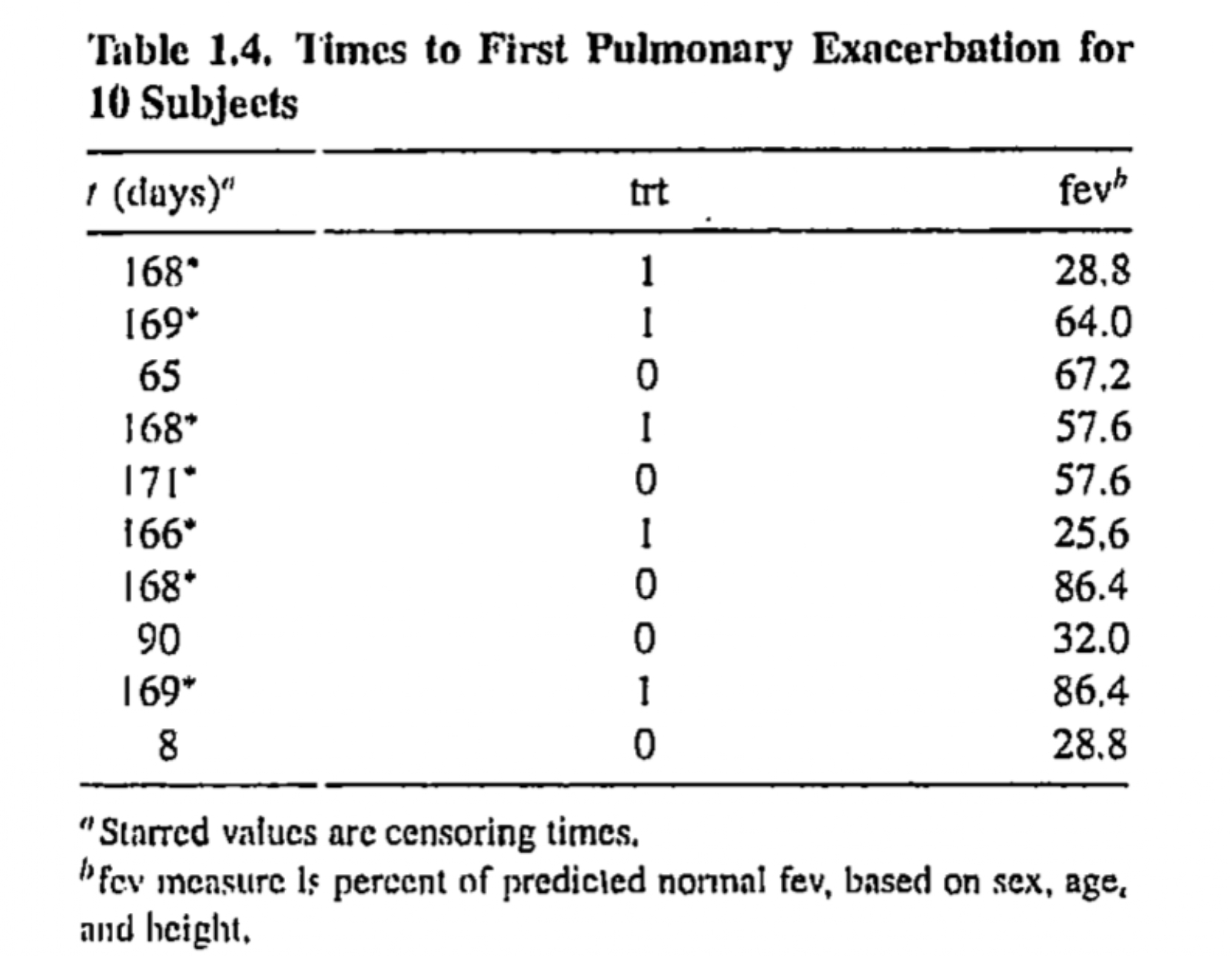| time | x |
|---|---|
| 3 | 1 |
| 5 | 0 |
| 8 | 1 |
| 4+ | 1 |
| 10 | 0 |
Chapter 7
(AST405) Lifetime data analysis
7 Semiparametric Multiplicative Hazards Regression Models
7.1 Methods for continuous multiplicative hazards model
Models in which covariates have a multiplicative effect on the hazard function play an important role in the analysis of lifetime data
Proportional hazard (PH) model is one of such models
Depending on whether baseline hazard function is left arbitrary or not, PH model could be either semiparametric or parametric
In this section, semiparametric PH models are discussed, where baseline hazard function is left arbitrary
-
The hazard function is modeled as
-
-
-
- Covariate vector
- No intercept term is included in
-
Model (Equation 7.1) is known as “Cox’s proportional hazards model” or simply “Cox model”
No distributional assumption is required for estimating the parameters of the Model (Equation 7.1)
The cumulative baseline hazard function is defined as
The baseline survivor function
The survivor function of
Estimation of model parameters
Data
Parameters of interest are
Log-likelihood function
- No unique solutions of the parameters because the number of parameters to be estimated is greater than the number of observations
Complete likelihood function is not useful for estimating parameters of Cox’s proportional hazards model
There are a number of different likelihood functions defined for estimating parameters, of which Cox’s “partial likelihood function” is widely used for PH models
-
Log-partial-likelihood function is defined as
-
-
Partial likelihood function can be treated as a regular likelihood function for making statistical inference
For partial likelihood function, the parameters of interest is
The baseline hazard functions are estimated from the full likelihood function with regression parameters are assumed to be known, i.e.
- Obtain the expression of partial likelihood function for the following censored sample
7.2 Comparison of two or more lifetime distributions
Let
-
Data available
Null hypothesis
Consider PH model
We can obtain
The null hypothesis under proportional model assumption
Large sample-based property of MLE
- Log-likelihood function
-
Score function
- Information matrix
Confidence interval for
Under
-
Test statistic
- MLE of
- MLE of
The expression of
At time
| group | event | alive | at risk |
|---|---|---|---|
| 1 | |||
| 2 | |||
- This score test for the Cox model to compare two groups is also known as log-rank test.
Example 7.1.1
Data below show remission times (in weeks) for 40 leukemia patients who were randomly assigned either treatment
tab7_1_1# A tibble: 40 × 3
time status group
<dbl> <dbl> <chr>
1 1 1 A
2 3 1 A
3 3 1 A
4 6 1 A
5 7 1 A
6 7 1 A
7 10 1 A
8 12 1 A
9 14 1 A
10 15 1 A
# ℹ 30 more rowssurvdiff(Surv(time, status) ~ group,
data = tab7_1_1) Call:
survdiff(formula = Surv(time, status) ~ group, data = tab7_1_1)
N Observed Expected (O-E)^2/E (O-E)^2/V
group=A 20 17 21.5 0.951 2.36
group=B 20 20 15.5 1.322 2.36
Chisq= 2.4 on 1 degrees of freedom, p= 0.1 coxph(Surv(time, status) ~ group, data = tab7_1_1) %>%
tidy()# A tibble: 1 × 5
term estimate std.error statistic p.value
<chr> <dbl> <dbl> <dbl> <dbl>
1 groupB 0.503 0.332 1.51 0.130Example 7.2.1
Patients with cystic fibrosis are susceptible to an accumulation of mucus in lungs, which leads to pulmonary exacerbation and deterioration of lung function
-
A clinical trial was conducted to investigate the efficacy of the new drug DNase-1
- Subjects are randomly assigned to a new treatment or a placebo
Time of interest is the time to first exacerbation after randomization and data on fev (forced expiatory volume at the time of randomization) are also measured

Creating the data from the R object rhDNase
tab1_4 <- as_tibble(rhDNase) %>%
filter(is.na(ivstart) | ivstart > 0) %>%
mutate(time0 = as.numeric(end.dt - entry.dt),
status = as.numeric(!is.na(ivstart)),
time = if_else(status == 1, ivstart, time0),
fevm = fev - mean(fev)) %>%
group_by(id) %>%
mutate(visit = n()) %>%
ungroup()Cox’s PH model
mod1 <- coxph(Surv(time, status) ~ trt + fevm,
data = tab1_4)Estimates of regression coefficients
tidy(mod1)# A tibble: 2 × 5
term estimate std.error statistic p.value
<chr> <dbl> <dbl> <dbl> <dbl>
1 trt -0.352 0.106 -3.31 9.47e- 4
2 fevm -0.0188 0.00226 -8.31 9.63e-17Treatment group patients have lower hazard for time to first exacerbation
As FEV value increases the hazard of first exacerbation decreases
Effects of treatment and FEV are significant on the hazard of first exacerbation decreases
| term | estimate | p.value | HR | 2.5 % | 97.5 % |
|---|---|---|---|---|---|
| trt | -0.352 | 0.001 | 0.703 | 0.571 | 0.867 |
| fevm | -0.019 | 0.000 | 0.981 | 0.977 | 0.986 |
Treatment group patients have about
For 1-unit increase of FEV value, hazard of first exacerbation decreases about
survfit() provides estimate of survivor function and corresponding standard errors
tidy(survfit(mod1)) %>%
as_tibble()# A tibble: 161 × 8
time n.risk n.event n.censor estimate std.error conf.high conf.low
<dbl> <dbl> <dbl> <dbl> <dbl> <dbl> <dbl> <dbl>
1 1 761 1 0 0.999 0.00138 1 0.996
2 5 760 3 0 0.994 0.00277 1.00 0.989
3 6 757 1 0 0.993 0.00311 0.999 0.987
4 8 756 4 0 0.988 0.00420 0.996 0.979
5 9 752 3 0 0.983 0.00489 0.993 0.974
6 11 749 2 0 0.981 0.00530 0.991 0.971
7 13 747 2 0 0.978 0.00569 0.989 0.967
8 14 745 2 0 0.975 0.00606 0.987 0.964
9 15 743 4 0 0.970 0.00675 0.983 0.957
10 16 739 2 0 0.967 0.00708 0.980 0.953
# ℹ 151 more rows